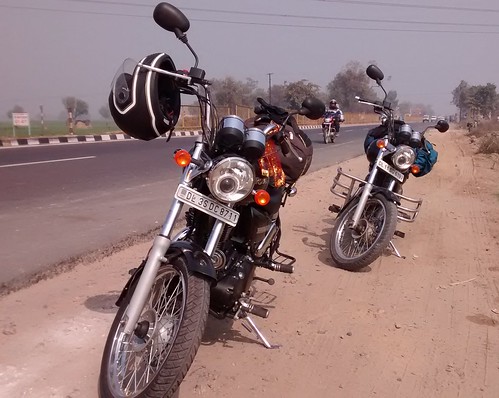The Plan
I had to take Typhon back to Pune. I did not want him to be ignored all the time I was planning to be out of the country. So it was going back to Pune where it would get the attention it deserved. But I was not yet decided on the route. Time was a smaller constraint and I had planned to do Rajasthan initially, attending the Ragasthan festival before continuing onwards to Rann of Katch and thence to Pune. But the event got scrapped and I now had options. The other route, as suggested by Parag, was through the tiger reserves in Madhya Pradesh. That was something I was considering quite intently since I had never sighted a tiger till date but had heard quite a few awesome stories.
A stomach infection aggravated by negligence during a few days of train commute robbed me of a few precious days and I was now looking at a 5-6 day ride from Delhi to Pune. After a lot of thought and deliberation, I chose to take the route via Madhya Pradesh, focusing on Khajuraho Temples and a safari in Panna Tiger Reserve as the highlight of my trip. A friend from Roorkee, Amit Bansal (a.k.a. BBC), decided to join me for some part of the journey. He too had a Royal Enfield Thinderbird 500, the same model as mine, and had a month off work. I had sufficiently recovered from my health problems and we fixed a Monday morning for departure.
Delhi to Jhansi, Batesara Temples, Kingfisher Gold
The alarm woke us up at 6 AM and we were quick to pop out of the bed. We were on the road by 6:30 AM, while the world around was still dark. We refueled our bikes before hitting the outer ring road of Delhi that would take us to Noida. Driving on the vast and broad roads of Delhi gives you a sense of the numbers that the city caters to. These roads, for all their width, become helplessly impuissant under the brunt of the day’s traffic. But this time of the morning, it was just us and the loaded trucks plying on the illuminated roads. Morning colours started filling the canvas ere we crossed the Yamuna to the other side. The weather was on the colder side but we had left aptly prepared. We crossed Noida before the day’s traffic had begun and were cruising down the link road to Greater Noida when an orange sun came up in the eastern sky. It played hide and seek awhile behind the trees and the tall SEZ buildings. It was a mellow orange, pleasant to look at and admire. In time, however, it broke free of the earthly trite and ascended into the heavens. It’s orange changed hues quickly, from a deep orange to a brighter one and then to a smouldering yellow that forbade a look. It had changed from an object of admiration to an object of majesty.
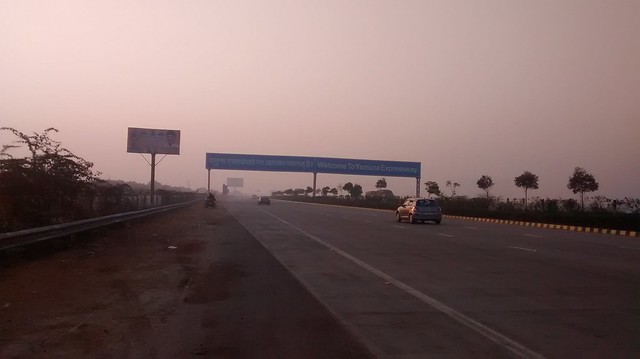 Entering the Yamuna Expressway
Entering the Yamuna Expressway
We found ourselves on the Yamuna Expressway shortly after. This is one of the more sensible expressways that allows two wheelers to ply on it if they agree to pay an appropriate toll fare. Right now it stands at INR 175 from Noida till Agra. I have always found the exclusion of two wheelers from expressways a stupid decision. It no longer makes sense in the age of superbikes when a two wheeler can go as fast, if not faster, than the stipulated speed limits. As far as safety goes, you cannot keep people safe by banning them from plying on roads. Do something more sensible like fining people who drive on the wrong side of the road (as many that we had witnessed on the expressway), or for driving in the wrong lane. For some reason people choose banning things over encouraging a more sensible behaviour.
We stopped once for some overpriced tea on a highway dhaba. The tea was good and we sipped on it glad for the break from the cold wind that was beating down on us. The sun had come up and was slowly spreading out it’s warmth to the world. After the tea we put our helmets back on and resumed our journey. It was around Mathura that we encountered a thick fog cover on the road. The visibility quickly dropped to a few meters and in the thicker parts it was no more than a few feet! We reduced our speeds and put on out headlights and indicators. Fog on a high speed road is never good. The temperature dropped in tandem with the visibility. The yellow sun was but a small dot of white, powerless in the face of such a mighty enemy. We rode in fog for almost fifty kilometers.
Eventually the cover lifted a little outside Agra. We left the expressway and took the road that would take us to the erstwhile capital of the Mughal Empire. After the uncongested expressway, driving on the UP roads amongst rowdy auto-walahs and bikers took a bit of adjustment of senses. I dodged motorcycles darting diagonally across the road, blaring their horns for no good reason. We got caught in a temporary traffic jam right outside Agra. A traffic policeman ran around beating auto-walahs with a stick while they shamelessly gathered commuters inconsiderate of their clogging the narrow streets. Good old North India! We skirted the Agra city, passing Itmad-ud-Daula and Agra Fort before hitting the Agra-Gwalior road. We did not stop to see any of the beautiful monuments that adorned the city of Agra. They would have to wait for another time. However, we did take a detour of a couple of kilometers to go to a shop on MG Road which is famous for it’s kachodi-sabji. BBC, a native of Agra, told me that a crowd was to be seen gathering around the shop since 7 in the morning! We sampled the famous breakfast items and it was well worth the hype. Kevin needed his share as usual so he came out to join us for the breakfast. After ending the first meal of the day with 50 grams of delicious and crispy jalebis, we hit the Gwalior road again and road out of the city of the Taj.
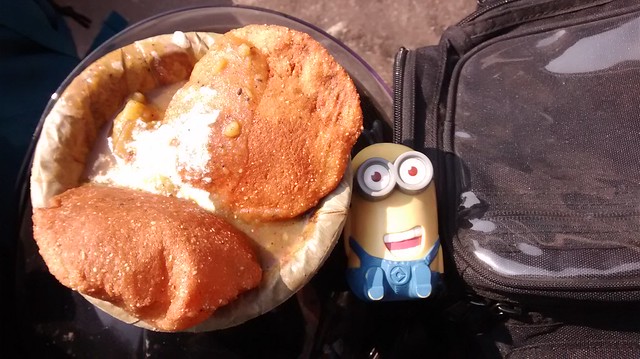 Kevin loved the breakfast at Deviram's in Agra
Kevin loved the breakfast at Deviram's in Agra
The road was a well made four lane highway. Later I realised that this was AH43, a part of the ambitious Asian Highways project. The road led us across the UP border into Madhya Pradesh, which was to be the highlight of this road trip. Once in MP, we were faced with a rather dangerous and amusing problem. Wrong side driving is a common problem in India; but, while in most of the country the wrong side drivers sneak around in far end of the road, the motorists of MP have taken it up a notch. They drive in the wrong side’s fast lane with zero fucks given! I was a little shocked to see a car appear out of nowhere followed by a tractor and a few motorcycles, all coming right at me when I was doing a 80 kmph on the highway. Initially I thought that maybe the other side of the highway was under repair or something, but it was a similar scene on the other side. Apparently the state does not believe in one ways. Every road is a two way. Period.
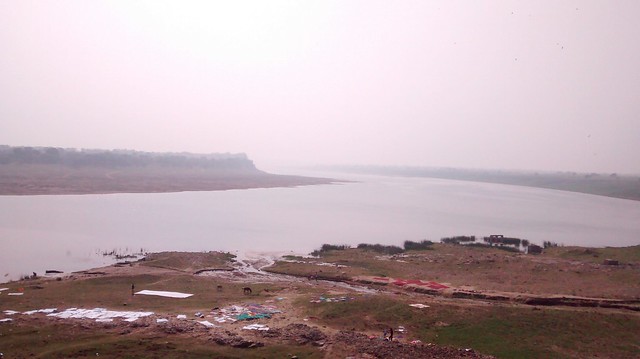 The mighty Chambal river
The mighty Chambal river
Approximately 50 km out of Agra we crossed the small town of Dholpur and then came the grand Chambal river. It was a massive river with a lot of volume. We stopped to click a few pictures that might capture the grandness of the river. A new bridge was under construction and a few washermen had laid out clothes to dry on the river’s banks. The sun shone strong and the water glimmered as it flowed by at an easy pace. We crossed the river and the landscaped changed to the infamous ravines of the Chambal valley. These lands were teeming with gangs of dacoits till a few years ago, and while most such outlaws have rectified their ways, few still persist in these devious landscapes. Beyond the ravines lay green farmlands and more good roads. We crossed the town of Morena and deviated from the main highway around 20 kilometers out of the town at a village named Nurabad.
The road was now a rustic one. It existed in places and in others was replaced by a dirt track. We even crossed a railway track without a proper crossing. Following the example of the villagers ahead of us, we used stones as ramps to jump our bikes over the steel tracks. The roads led us inland among fields and mining quarries. We drove at an easy pace, enjoying the scenery and on a lookout for the reason that we had chose to leave the highway. At length it presented itself in the form of a single temple standing on an elevated platform. We turned our bikes in the direction and entered the complex of the Batesara Temples. My father had told me about this place when I has told him about the route. He had heard about the restoration work in some news, and since it sounded interesting, I had put it on the itinerary. We checked out the temple that was visible from the road, climbing the flight of steps only to realise that the main cluster of temples lay a little further ahead. But this one was a beauty in itself. Although the restoration work was not complete, the pillars were quite beautifully adorned and we took a short break from the sun, enjoying the flimsy breeze that blew in from the north.
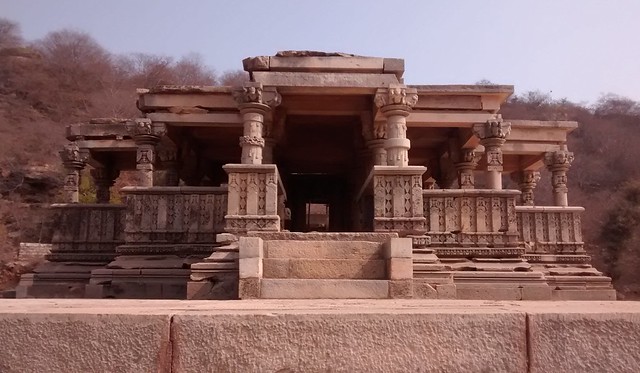 The Temple outside Batesara Cluster
The Temple outside Batesara Cluster
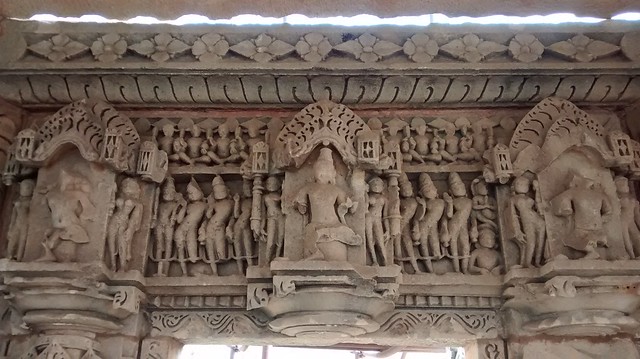 Exquisite Stone Work Adorning the Gateway of the Inner Chamber
Exquisite Stone Work Adorning the Gateway of the Inner Chamber
Then we went a little ahead to the main cluster of temples. We left our luggage strapped on to the bikes. Despite this being the land of dacoits, I felt pretty confident that no one would go through the trouble of unstrapping them and running away with the heavy bags. We walked into the complex that had no other tourists other than us. A few villagers sat in a grassy park in the shade of trees discussing something seemingly important. I read the description of the complex at the entrance. Then we went ahead to admire the beauty of the restored temples. It is a commendable effort that ASI (Archaeological Survey of India) has put into the restoration work. You can get a faint idea of the complexity by looking at the heaps of rubble lying around. The restored structures were once a part of that chaos. There was a small shivlinga in most of these small temples. The shikharas and gates were adorned with beautiful masonry. A little further lay a pool of water of toxic green complexion. A man with white hair and moustache, clad in a white lungi pointed us in the direction of the Bhootnath temple, the main Shiva temple of the complex. Then the priest proceeded to draw green water from the kund and wash his hair with a nonchalance befitting his trade. I would have missed the temple had I not asked which one it was. It was so utterly uncared for from the outside, camouflaged among the heaps of broken pillars and walls. On the inside, big shivlingas stared at us from all directions. The main chamber was decorated with flowers and bells hung in a bunch. There was nothing else to the complex. Fifteen to twenty minutes were all that was required to see this place. Post that you could either lounge around in the shade and discuss village politics if you had something to contribute, else you could leave to your next destination. We chose the latter.
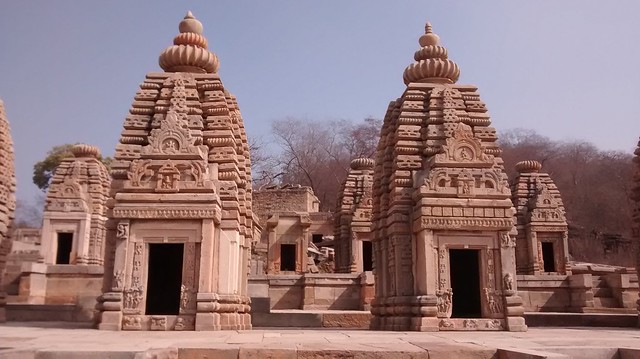 Recontructed Stone Temples
Recontructed Stone Temples
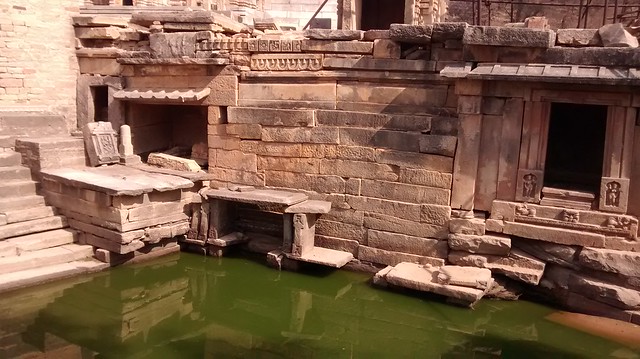 The Kund at Batesara
The Kund at Batesara
As we rode out of the complex, there was another ancient structure, apparently a fort or a palace, not far from the Batesara group. If we had stopped there then Jhansi would have been pushed to post nightfall. So we satisfied ourselves with an external tour of the Padhavati ruins and proceeded towards Gwalior. Once we hit the main highway, we bypassed the city and stopped at a dhaba for lunch. We had dal and sev bhaji (a preparation much like sev tamatar except that it is milk based and less spicy) with some rotis. The food was quite delicious and we enjoyed the meal. As we ate, a gentleman came to me to ask for my helmet. The government was encouraging wearing helmets on two wheelers by mandating that the fuel stations refuse giving fuel to those that do not wear a helmet. A commendable initiative but it might take some time to catch on. People would rather waste minutes searching for a helmet than buy one. And even if they do buy it, I am sure they would carry it just to buy fuel and not wear it. You cannot make people value their lives. You can cause them inconvenience or make them fear punishment, but it is not the same.
The road after Gwalior was a mess. The highway was under construction and the now familiar two way concept became justified. We moved slowly with the traffic, passing crowded towns and cities on the way to Jhansi. The sun had travelled across the heavens and vanished on the western side by the time we hit the outskirts of Jhansi. There was still light though and we were happy to have made the journey during daylight as planned. We thought of going towards the railway station. Cheap lodges and guest houses are usually available around the railway and bus stations. We parked our bikes next to a tea stall and inquired around. While BBC stood guarding the bikes and the luggage, I went to take a look at the recommended guest houses. The ones on the highway seemed overpriced so I went inside a lane. Here I hit upon a certain Shashi Palace, another of the recommended ones and found the offer to my liking. The proprietress, however, was at a loss as to why I was in Jhansi. She was shocked that I was coming from Delhi on a bike, wanted to know whether my friend was a male or female, told me that ID cards would be required, wanted to know why I was going to Panna the next day, told me I had to check out before 12 noon the next day. I tried to answer her questions as patiently as I could. I had been subjected to such suspicious interrogations before. Then I went back to get BBC and the bike. We parked the bikes and settled down in the dilapidated room. There was a lot wrong with the room but we just had to spend a night. I was sure we could survive.
We freshened up quickly and decided to celebrate the 492 kms of the day with some beer and a dinner. However, even that is not simple in Jhansi! Alcohol and food are not served under the same roof. You need to get your own booze and sit in a dhaba. And if your taste calls for lager beer, well, you are in for a tougher time! But we managed somehow; Kingfisher Gold (erstwhile Premium) and some good tandoori chicken. After a relaxed hour over drinks, we walked back to the room and eventually went to sleep among buzzing mosquitoes.
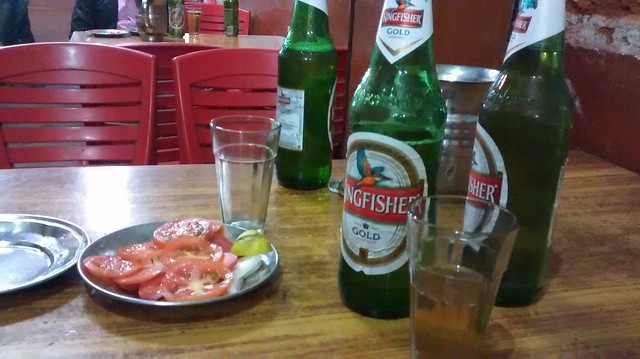 A few Kingfisher Golds to end the day!
A few Kingfisher Golds to end the day!
[Read about Day 2 here.](/post/delhi-pune-day-2/)
Here is the route taken on Day 1 on Google Maps.
And here is a complete album of the road trip.
